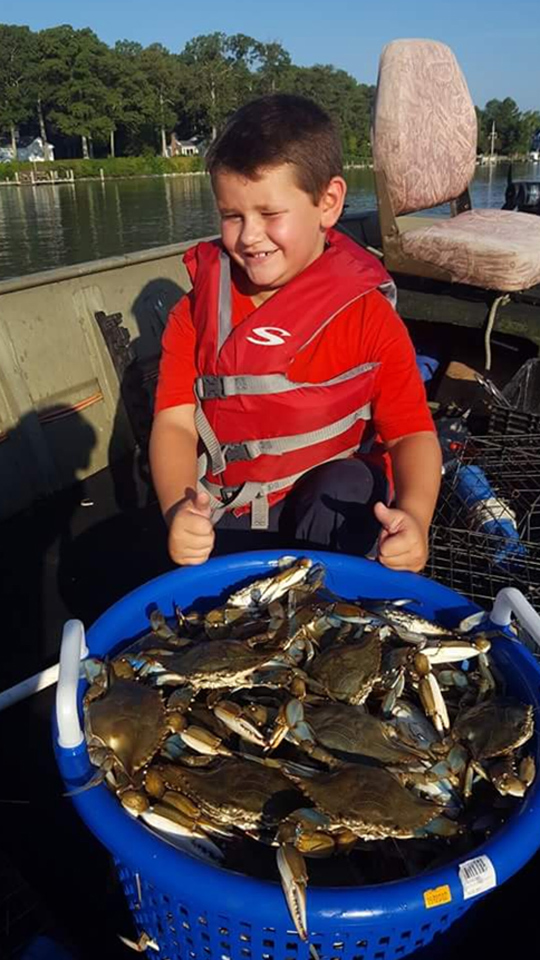While trot-lining for crabs is generally considered the most efficient method of harvesting a bushel basket full of cranky crustaceans, running a trot line also requires a certain amount of skill – and a whole lot of work. The baiting process alone can take an hour, de-baiting the line is almost as tedious, and showering yourself with chicken neck juices during the experience is not exactly delightful. Still, if there’s any one activity worth missing a few hours of fishing for, it’s crabbing. Those southerners can have their shrimp and those northerners are welcome to their lobster, because in Chesapeake country there’s simple nothing we love more than sitting down to a pile of jimmies steamed over beer and vinegar and loaded up with Old Bay. (If you’re shaking your head “no,” we officially banish you to North Dakota). Pull traps, as opposed to trot lines, are quite easy to bait and operate, and require much less of a time-investment. To get some trap-pulling insight we spoke with Jim Bieler, of Marty’s Bait and Tackle, who uses pull-traps in addition to trot lines himself.

“I use traps early in the season and late in the season,” he explains, “when you don’t really know just where the crabs will be and you do know you’ll have to search a bit. You can set a few in each different depth range and as you catch a crab here or there, shift all the others into the productive area. With a trot-line, you’d have to pull the whole thing in to re-position it. But a lot of people use traps all the time, regardless of the season, simply because they’re easy to use. You can buy a batch of traps and catch a batch of crabs all in the same day, without a whole lot of learning or preparation.”
Once the season is in full swing, it’s usually best to concentrate between five and seven feet of water. Still, however, savvy crab-trappers will set a few test-traps in different depths just to be sure. Weather and tide can sometimes drive the crabs to congregate in depths that you hadn’t necessarily expected. Also look for cuts and creek mouths, which crabs tend to congregate near, and place your traps outside of them. Underwater humps and bars can be very productive as well.
Jim says that when gearing up you should consider using topless traps, because they can be stacked for much easier storage and won’t take up nearly as much room on the boat. He suggests using a bungee cord to secure the traps in each stack together.
“Don’t worry about the crabs swimming out,” he says. “They swim sideways and down when they’re scared, and as long as you give a quick pull at the start to close the trap’s doors, then pull in the line briskly, they almost never swim out the top.”
What about hoop traps, which have a pair of rings combined with cotton netting? While they work on the same principal are can be effective, Jim notes that in his experience, they deteriorate rather quickly. Plus if an angry crab clamps a claw around the netting, it can be tough to get the feisty critter out without causing damage. Topless pull traps, on the other hand, will last for years on end.
All other factors aside, perhaps the best thing about using pull-traps as opposed to running a trot-line is that your kids can get involved. They won’t merely be riding along, as might happen when trot-lining, but can play an active role by pulling in the traps. Even four or five year olds can pull up a line (though you’ll probably want to grab the float and make the initial tug,) and they’ll be thrilled beyond words each and every time a trap breaks the surface with a crab scuttling around in the bottom. That’ll give them a serious sense of accomplishment – and it’ll give the entire family the best meal on the face of the planet.

5 Top Pull Trap Crabbing Tips
- Depending on the current, one side or the other of a point may be significantly more productive at any given time. When in search mode, it’s always a good idea to set half your traps on one side of a point and the others on the opposite side. After a couple-few rotations pulling all the traps up, you should know which side to then focus all your effort on.
- Rig about 12 feet of line to each trap. It’s rare you’ll want to crab in water deeper than 10 feet, and when crabbing in shallower water, you can always leave some of the line wrapped around the float.
- Stick with chicken necks for bait. They’re easy to secure in place, last a long time, and the crabs love ‘em.
- Don’t give the traps a ton of soak-time. Pulling each one only takes it out of action for a moment, and if a crab is in there while you wait, it’ll just tear up the bait. When you have a dozen or more traps in the water, you should be constantly pulling one after the next.
- Try running your traps early in the day and late in the day. Just like fish, this is usually when the crabs are most active.